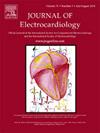从标准的12导联心电图推导出抬高电极放置心电图(EEP-ECG)导联的数学模型。
IF 1.3
4区 医学
Q3 CARDIAC & CARDIOVASCULAR SYSTEMS
引用次数: 0
摘要
背景:在较高肋间隙放置右心前导联(EEP-ECG)可提高Brugada综合征(BrS)的检出率。考虑到导联放置的潜在困难和BrS心电图模式的短暂性,我们开发了一个模型来预测标准12导联心电图的EEP-ECG。目的:建立并验证一种从标准12导联心电图中导出心电导联的模型。方法:使用两台相同的心电记录仪记录16通道心电图(12根标准导联加4根肋间隙抬高导联)。根据训练组心电图数据建立线性回归模型。该模型随后用于预测验证组的eeg - ecg。通过比较推导出的引线和实际记录的引线来评估模型的准确性。两名心脏病专家在1-3的范围内使用相关系数和视觉评估进行比较。结果:共纳入42例受试者(训练组22例,验证组20例),其中BrS患者8例。该模型显示,80个导联中有76个导联的实际导联与预测导联之间存在很强的相关性(r >.85)。视觉评分平均为2.44±0.68分。该模型已作为在线工具提供,用于从标准12导联心电图自动推导eeg -ECG (http://eep-ecg.in/)。结论:我们开发了一个线性模型,从标准的12导联心电图中推导出升高的心电图导联。该模型对心电电位的预测精度较高。该模型可用于诊断新的或现有的心电图中的BrS。本文章由计算机程序翻译,如有差异,请以英文原文为准。
A mathematical model for derivation of Elevated-Electrode-Placement Electrocardiogram (EEP-ECG) leads from a standard 12-lead electrocardiogram
Background
Placement of right precordial leads in higher intercostal spaces (EEP-ECG) improves the detection of Brugada Syndrome (BrS). Given the potential difficulty of lead placement and the transient nature of BrS ECG patterns, we developed a model to predict EEP-ECG from a standard 12‑lead ECG.
Objective
To create and validate a model that derives EEP-ECG leads from a standard 12‑lead ECG.
Methods
We recorded 16 channel ECGs (12 standard leads plus 4 elevated leads in the 2nd and 3rd intercostal spaces) using two identical ECG recorders. A linear regression model was developed from the ECG data in the training group. This model was subsequently used to predict EEP-ECG in the validation group. Accuracy of the model was evaluated by comparing the derived leads to the actually recorded leads. Comparison was done using correlation coefficients and visual assessment by two cardiologists on a scale of 1–3.
Results
The study included 42 participants (22 in the training group, 20 in the validation group), including 8 BrS patients. The model showed strong correlation (r > 0.85) between actual and predicted leads for 76 of 80 leads. Visual assessment yielded an average score of 2.44 ± 0.68. The model has been made available as an online tool for automatic derivation of EEP-ECG from a standard 12‑lead ECG (http://eep-ecg.in/).
Conclusion
We developed a linear model to derive elevated ECG leads from standard 12‑lead ECGs. The model predicts EEP-ECG with reasonable accuracy. This model can be useful in diagnosing BrS in new or existing ECGs.
求助全文
通过发布文献求助,成功后即可免费获取论文全文。
去求助
来源期刊

Journal of electrocardiology
医学-心血管系统
CiteScore
2.70
自引率
7.70%
发文量
152
审稿时长
38 days
期刊介绍:
The Journal of Electrocardiology is devoted exclusively to clinical and experimental studies of the electrical activities of the heart. It seeks to contribute significantly to the accuracy of diagnosis and prognosis and the effective treatment, prevention, or delay of heart disease. Editorial contents include electrocardiography, vectorcardiography, arrhythmias, membrane action potential, cardiac pacing, monitoring defibrillation, instrumentation, drug effects, and computer applications.
 求助内容:
求助内容: 应助结果提醒方式:
应助结果提醒方式:


